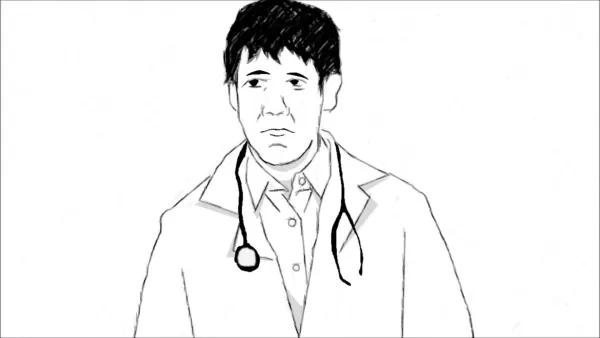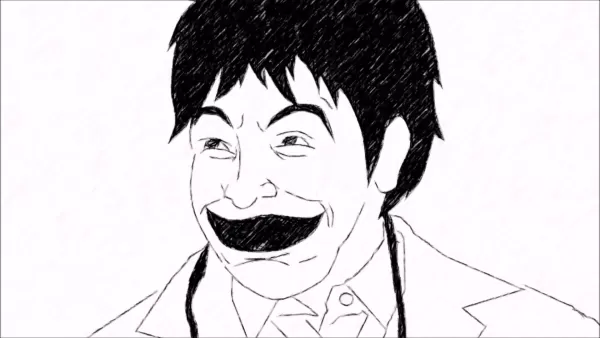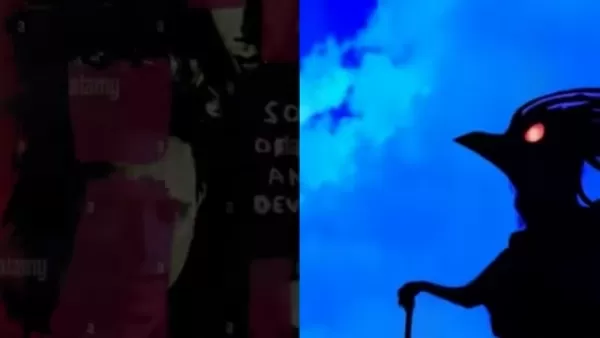AI-Powered Dark Comedy: Exploring an Infected Doctor Scenario
What unfolds when AI crafts a darkly funny yet unsettling scenario? This analysis dives into a comedic animation powered by AI, portraying an infected doctor narrative. The piece explores the animation’s themes, societal fears it evokes, and the role of dark humor in addressing these anxieties. It also examines the AI-driven infected doctor depiction and reflects on audience reactions and broader implications.
Key Points
AI creates a comedic animation featuring an infected doctor scenario.
The animation employs dark humor to tackle disturbing themes.
Characters respond with wit, shock, and exaggerated violence to the AI-generated events.
The narrative highlights societal fears surrounding health and mortality.
Insights into the animation’s themes and their potential impact.
Exploring the AI Simulation
The Concept Behind the AI-Driven Infected Doctor
The animation centers on an AI-generated scenario featuring an infected doctor in a hospital setting.

The story places characters in a hospital confronted by a compromised medical professional, blending dark humor with unexpected reactions to probe anxieties about health and mortality. The AI’s role in crafting this narrative raises questions about technology’s influence on creating provocative content. The animation opens with the protagonist waking disoriented in a hospital bed, setting a tone of vulnerability. The familiar, sterile hospital environment quickly unravels as the infected doctor emerges, recognizable yet disturbingly altered. This figure drives the narrative, exploring themes of trust, fear, and societal collapse amid unforeseen threats. As the plot unfolds, characters’ exaggerated reactions amplify the absurdity, infusing the scenario with surreal humor. The AI’s simulation taps into modern concerns about technology’s ability to blur reality and fiction, making viewers laugh while confronting discomfort. Beyond humor, the animation reflects on how we process challenging information that disrupts our sense of safety and normalcy.
Humor and Reactions: A Playful Twist on Crisis
The comedy stems from characters’ wild reactions to the bizarre AI-crafted scenario.

One character, facing the infected doctor, quips, “Doctor, who’s this?”—a lighthearted jab that injects absurdity into the tense moment. The humor escalates with over-the-top responses, including a character leaping from a hospital bed in denial after a grim diagnosis and, in a surreal twist, hurling themselves out a window. This exaggerated chaos contrasts the orderly hospital setting, creating a comedic clash. The diagnosis itself fuels dark humor through misunderstandings and misinterpretations, crafting a memorable, laugh-out-loud experience. The animation uses these extreme reactions to highlight the absurdity of existential threats, prompting reflection on human responses to crises. It also tests the boundaries of comedy, as the humor grows darker, challenging viewers to consider what’s acceptable. By blending unexpected reactions with surreal events, the animation delivers a thought-provoking yet entertaining experience.
Anxieties and Insights: Probing Deeper Fears
Beyond laughs, the AI simulation uncovers societal fears tied to health and mortality.

The infected doctor narrative taps into concerns about the reliability of the medical system, the vulnerability of healthcare professionals, and life’s fragility. Characters’ disbelief, denial, and violent outbursts mirror real-world responses to crises, reflecting feelings of helplessness. The animation’s commentary underscores these fears, suggesting that extreme threats can push individuals to desperate acts. It prompts viewers to question their own reactions in similar scenarios and explores the tension between self-preservation and collective action. Rather than offering solutions, the animation invites reflection on the emotions, fears, and societal structures shaping crisis responses. By using humor to disarm, it creates space to confront uncomfortable truths, sparking discussions on resilience, trust, and empathy in uncertain times. The AI-driven narrative serves as a mirror, reflecting our anxieties and encouraging deeper understanding.
Key Elements of Effective Dark Humor
Navigating the Edge of Dark Comedy
Dark humor thrives on tackling taboo or distressing topics, turning them into laughter.

Its power lies in confronting tough subjects to process complex emotions through humor. Success hinges on balancing humor with sensitivity to avoid offense. Surprise is key—twisting serious scenarios with unexpected jokes creates cathartic laughter. Timing and context are critical; a poorly timed joke risks insensitivity. Relatability grounds the humor, connecting audiences through shared truths, even in absurd scenarios. Targeting institutions or power structures, rather than vulnerable groups, enhances acceptability. Effective dark humor demands sharp insight into psychology, social dynamics, and timing, serving as a tool to challenge norms, process pain, and build community when executed thoughtfully.
Evaluating the AI Doctor Simulation: Strengths and Weaknesses
Pros
Sheds light on societal fears about health and mortality.
Uses humor to explore a spectrum of emotions, from amusement to unease.
Tests the boundaries of comedic expression.
Encourages reflection on emotions, fears, and societal dynamics in crises.
Cons
Dark humor’s success depends on delicately balancing humor with sensitivity.
Misjudged timing or context can make jokes seem insensitive or flat.
Frequently Asked Questions (FAQ)
What is AI simulation?
AI simulation involves using artificial intelligence to model real-world scenarios or systems, enabling testing, training, or exploring outcomes.
Why incorporate dark humor in this animation?
Dark humor addresses unsettling themes like health and mortality, disarming viewers to engage with tough topics through laughter.
What societal fears does the animation explore?
It highlights anxieties about the medical system’s reliability, compromised healthcare professionals, and human vulnerability.
Related Questions
How does AI enhance comedic animations?
AI aids in scriptwriting, character design, animation, and timing feedback, enabling personalized and dynamic comedic content.
What ethical issues arise from AI simulating disturbing scenarios?
Ethical concerns include creating harmful or offensive content, perpetuating stereotypes, and the potential for AI to manipulate or mislead audiences.
How do cultural backgrounds or personal experiences shape reactions to dark humor?
Responses vary widely; cultural norms and personal traumas influence whether dark humor feels funny or offensive, highlighting its subjective nature.
Related article
 AI-Generated Crossover Unites Arthur Morgan and Joshua Graham in Gaming Multiverse
When Gaming Worlds Collide: Arthur Morgan Meets the Burned ManPicture a realm where legendary game characters step beyond their own stories - what unfolds when Red Dead Redemption 2's Arthur Morgan crosses paths with Fallout: New Vegas' scarred proph
AI-Generated Crossover Unites Arthur Morgan and Joshua Graham in Gaming Multiverse
When Gaming Worlds Collide: Arthur Morgan Meets the Burned ManPicture a realm where legendary game characters step beyond their own stories - what unfolds when Red Dead Redemption 2's Arthur Morgan crosses paths with Fallout: New Vegas' scarred proph
 Microsoft hosts xAI's advanced Grok 3 models in new AI collaboration
Earlier this month, my *Notepad* investigative journalism uncovered Microsoft's plans to integrate Elon Musk's Grok AI models - revelations that have now been officially confirmed. Today at Microsoft's annual Build developer conference, company execu
Microsoft hosts xAI's advanced Grok 3 models in new AI collaboration
Earlier this month, my *Notepad* investigative journalism uncovered Microsoft's plans to integrate Elon Musk's Grok AI models - revelations that have now been officially confirmed. Today at Microsoft's annual Build developer conference, company execu
 Depeche Mode's Faith Songs Get AI Remix & Deep Analysis
(or if shorter needed)
AI Remixes and Analyzes Depeche Mode's Songs of Faith
Depeche Mode's groundbreaking album Songs of Faith and Devotion stands as a defining moment in electronic music's evolution. Released in 1993 during the band's creative zenith, this masterwork boldly redefined their signature sound by blending indust
Comments (2)
0/200
Depeche Mode's Faith Songs Get AI Remix & Deep Analysis
(or if shorter needed)
AI Remixes and Analyzes Depeche Mode's Songs of Faith
Depeche Mode's groundbreaking album Songs of Faith and Devotion stands as a defining moment in electronic music's evolution. Released in 1993 during the band's creative zenith, this masterwork boldly redefined their signature sound by blending indust
Comments (2)
0/200
![BenjaminMiller]() BenjaminMiller
BenjaminMiller
 August 27, 2025 at 7:01:33 PM EDT
August 27, 2025 at 7:01:33 PM EDT
This AI-generated dark comedy about an infected doctor is wild! The humor’s so twisted, it’s like watching a medical sitcom from a parallel universe. Loved the creepy vibes! 😈


 0
0
![RalphGonzález]() RalphGonzález
RalphGonzález
 August 26, 2025 at 9:01:33 PM EDT
August 26, 2025 at 9:01:33 PM EDT
This AI-powered dark comedy sounds wild! An infected doctor scenario? It's like Black Mirror meets Scrubs. Can't wait to see how creepy yet funny this gets! 😄


 0
0
What unfolds when AI crafts a darkly funny yet unsettling scenario? This analysis dives into a comedic animation powered by AI, portraying an infected doctor narrative. The piece explores the animation’s themes, societal fears it evokes, and the role of dark humor in addressing these anxieties. It also examines the AI-driven infected doctor depiction and reflects on audience reactions and broader implications.
Key Points
AI creates a comedic animation featuring an infected doctor scenario.
The animation employs dark humor to tackle disturbing themes.
Characters respond with wit, shock, and exaggerated violence to the AI-generated events.
The narrative highlights societal fears surrounding health and mortality.
Insights into the animation’s themes and their potential impact.
Exploring the AI Simulation
The Concept Behind the AI-Driven Infected Doctor
The animation centers on an AI-generated scenario featuring an infected doctor in a hospital setting.

The story places characters in a hospital confronted by a compromised medical professional, blending dark humor with unexpected reactions to probe anxieties about health and mortality. The AI’s role in crafting this narrative raises questions about technology’s influence on creating provocative content. The animation opens with the protagonist waking disoriented in a hospital bed, setting a tone of vulnerability. The familiar, sterile hospital environment quickly unravels as the infected doctor emerges, recognizable yet disturbingly altered. This figure drives the narrative, exploring themes of trust, fear, and societal collapse amid unforeseen threats. As the plot unfolds, characters’ exaggerated reactions amplify the absurdity, infusing the scenario with surreal humor. The AI’s simulation taps into modern concerns about technology’s ability to blur reality and fiction, making viewers laugh while confronting discomfort. Beyond humor, the animation reflects on how we process challenging information that disrupts our sense of safety and normalcy.
Humor and Reactions: A Playful Twist on Crisis
The comedy stems from characters’ wild reactions to the bizarre AI-crafted scenario.

One character, facing the infected doctor, quips, “Doctor, who’s this?”—a lighthearted jab that injects absurdity into the tense moment. The humor escalates with over-the-top responses, including a character leaping from a hospital bed in denial after a grim diagnosis and, in a surreal twist, hurling themselves out a window. This exaggerated chaos contrasts the orderly hospital setting, creating a comedic clash. The diagnosis itself fuels dark humor through misunderstandings and misinterpretations, crafting a memorable, laugh-out-loud experience. The animation uses these extreme reactions to highlight the absurdity of existential threats, prompting reflection on human responses to crises. It also tests the boundaries of comedy, as the humor grows darker, challenging viewers to consider what’s acceptable. By blending unexpected reactions with surreal events, the animation delivers a thought-provoking yet entertaining experience.
Anxieties and Insights: Probing Deeper Fears
Beyond laughs, the AI simulation uncovers societal fears tied to health and mortality.

The infected doctor narrative taps into concerns about the reliability of the medical system, the vulnerability of healthcare professionals, and life’s fragility. Characters’ disbelief, denial, and violent outbursts mirror real-world responses to crises, reflecting feelings of helplessness. The animation’s commentary underscores these fears, suggesting that extreme threats can push individuals to desperate acts. It prompts viewers to question their own reactions in similar scenarios and explores the tension between self-preservation and collective action. Rather than offering solutions, the animation invites reflection on the emotions, fears, and societal structures shaping crisis responses. By using humor to disarm, it creates space to confront uncomfortable truths, sparking discussions on resilience, trust, and empathy in uncertain times. The AI-driven narrative serves as a mirror, reflecting our anxieties and encouraging deeper understanding.
Key Elements of Effective Dark Humor
Navigating the Edge of Dark Comedy
Dark humor thrives on tackling taboo or distressing topics, turning them into laughter.

Its power lies in confronting tough subjects to process complex emotions through humor. Success hinges on balancing humor with sensitivity to avoid offense. Surprise is key—twisting serious scenarios with unexpected jokes creates cathartic laughter. Timing and context are critical; a poorly timed joke risks insensitivity. Relatability grounds the humor, connecting audiences through shared truths, even in absurd scenarios. Targeting institutions or power structures, rather than vulnerable groups, enhances acceptability. Effective dark humor demands sharp insight into psychology, social dynamics, and timing, serving as a tool to challenge norms, process pain, and build community when executed thoughtfully.
Evaluating the AI Doctor Simulation: Strengths and Weaknesses
Pros
Sheds light on societal fears about health and mortality.
Uses humor to explore a spectrum of emotions, from amusement to unease.
Tests the boundaries of comedic expression.
Encourages reflection on emotions, fears, and societal dynamics in crises.
Cons
Dark humor’s success depends on delicately balancing humor with sensitivity.
Misjudged timing or context can make jokes seem insensitive or flat.
Frequently Asked Questions (FAQ)
What is AI simulation?
AI simulation involves using artificial intelligence to model real-world scenarios or systems, enabling testing, training, or exploring outcomes.
Why incorporate dark humor in this animation?
Dark humor addresses unsettling themes like health and mortality, disarming viewers to engage with tough topics through laughter.
What societal fears does the animation explore?
It highlights anxieties about the medical system’s reliability, compromised healthcare professionals, and human vulnerability.
Related Questions
How does AI enhance comedic animations?
AI aids in scriptwriting, character design, animation, and timing feedback, enabling personalized and dynamic comedic content.
What ethical issues arise from AI simulating disturbing scenarios?
Ethical concerns include creating harmful or offensive content, perpetuating stereotypes, and the potential for AI to manipulate or mislead audiences.
How do cultural backgrounds or personal experiences shape reactions to dark humor?
Responses vary widely; cultural norms and personal traumas influence whether dark humor feels funny or offensive, highlighting its subjective nature.
 AI-Generated Crossover Unites Arthur Morgan and Joshua Graham in Gaming Multiverse
When Gaming Worlds Collide: Arthur Morgan Meets the Burned ManPicture a realm where legendary game characters step beyond their own stories - what unfolds when Red Dead Redemption 2's Arthur Morgan crosses paths with Fallout: New Vegas' scarred proph
AI-Generated Crossover Unites Arthur Morgan and Joshua Graham in Gaming Multiverse
When Gaming Worlds Collide: Arthur Morgan Meets the Burned ManPicture a realm where legendary game characters step beyond their own stories - what unfolds when Red Dead Redemption 2's Arthur Morgan crosses paths with Fallout: New Vegas' scarred proph
 Microsoft hosts xAI's advanced Grok 3 models in new AI collaboration
Earlier this month, my *Notepad* investigative journalism uncovered Microsoft's plans to integrate Elon Musk's Grok AI models - revelations that have now been officially confirmed. Today at Microsoft's annual Build developer conference, company execu
Microsoft hosts xAI's advanced Grok 3 models in new AI collaboration
Earlier this month, my *Notepad* investigative journalism uncovered Microsoft's plans to integrate Elon Musk's Grok AI models - revelations that have now been officially confirmed. Today at Microsoft's annual Build developer conference, company execu
 Depeche Mode's Faith Songs Get AI Remix & Deep Analysis
(or if shorter needed)
AI Remixes and Analyzes Depeche Mode's Songs of Faith
Depeche Mode's groundbreaking album Songs of Faith and Devotion stands as a defining moment in electronic music's evolution. Released in 1993 during the band's creative zenith, this masterwork boldly redefined their signature sound by blending indust
Depeche Mode's Faith Songs Get AI Remix & Deep Analysis
(or if shorter needed)
AI Remixes and Analyzes Depeche Mode's Songs of Faith
Depeche Mode's groundbreaking album Songs of Faith and Devotion stands as a defining moment in electronic music's evolution. Released in 1993 during the band's creative zenith, this masterwork boldly redefined their signature sound by blending indust
 August 27, 2025 at 7:01:33 PM EDT
August 27, 2025 at 7:01:33 PM EDT
This AI-generated dark comedy about an infected doctor is wild! The humor’s so twisted, it’s like watching a medical sitcom from a parallel universe. Loved the creepy vibes! 😈


 0
0
 August 26, 2025 at 9:01:33 PM EDT
August 26, 2025 at 9:01:33 PM EDT
This AI-powered dark comedy sounds wild! An infected doctor scenario? It's like Black Mirror meets Scrubs. Can't wait to see how creepy yet funny this gets! 😄


 0
0





























